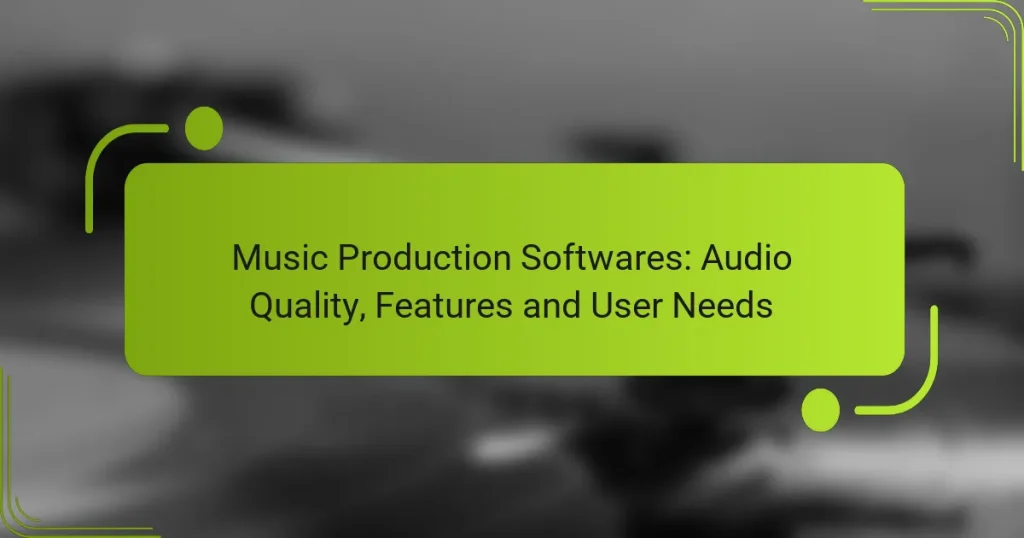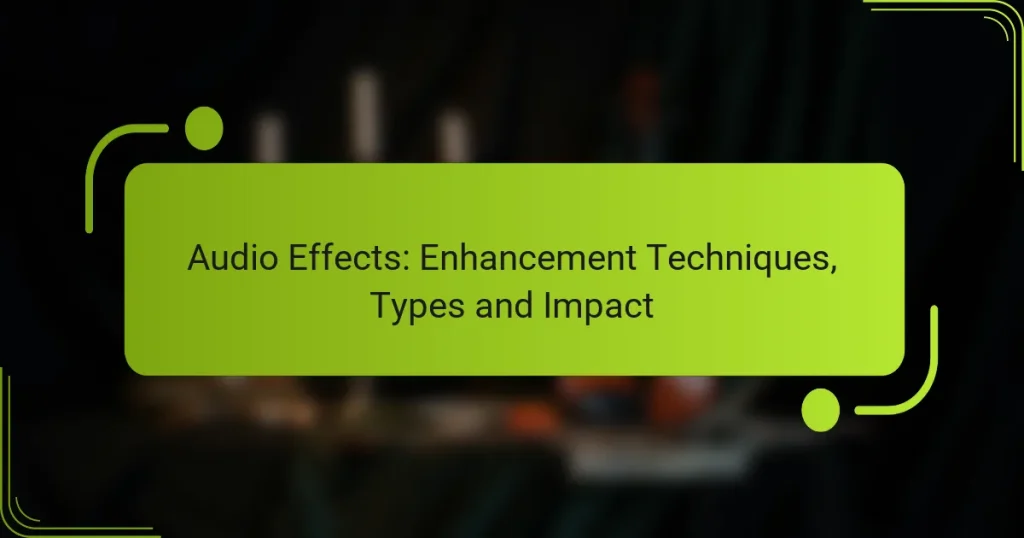Choosing the right music production software is essential for achieving high audio quality and creative versatility. Top programs like Ableton Live, FL Studio, and Logic Pro X excel in sound fidelity and offer a broad array of effects that can elevate raw recordings into polished tracks. When selecting software, consider features that enhance audio processing, compatibility with audio interfaces, and user-friendly interfaces to streamline your production process.
Audio Effects: Enhancement Techniques, Types and Impact
What are the best music production softwares for audio quality?
The best music production softwares for audio quality are those that provide high-resolution audio processing, robust mixing capabilities, and a wide range of effects. Programs like Ableton Live, FL Studio, Logic Pro X, Pro Tools, and Studio One stand out for their sound fidelity and versatility in music creation.
Ableton Live
Ableton Live is renowned for its intuitive interface and powerful audio manipulation features. It supports high-quality audio recording and playback, making it ideal for both live performances and studio work. The software excels in real-time audio processing, allowing users to experiment with effects and samples seamlessly.
When using Ableton Live, take advantage of its built-in audio effects like reverb and delay, which can enhance the overall sound quality. Additionally, its warping feature allows for precise timing adjustments without sacrificing audio fidelity.
FL Studio
FL Studio is popular among electronic music producers for its user-friendly layout and comprehensive audio quality features. It offers a variety of high-quality plugins and effects that can elevate your sound. The software supports up to 32-bit/192 kHz audio, ensuring professional-grade output.
To maximize audio quality in FL Studio, utilize its mixer for detailed control over individual tracks and effects. Experimenting with the built-in synthesizers and effects can lead to unique sound designs that stand out in your productions.
Logic Pro X
Logic Pro X is a powerful tool for Mac users, known for its exceptional audio quality and extensive library of sounds and effects. It supports high-resolution audio and offers advanced mixing capabilities, making it suitable for professional music production. The software includes a range of virtual instruments and plugins that enhance audio quality.
For optimal results, leverage Logic Pro X’s Flex Time and Flex Pitch features, which allow for precise editing of audio tracks. This can significantly improve the clarity and quality of your final mix.
Pro Tools
Pro Tools is considered the industry standard for audio production, particularly in professional studios. It offers superior audio quality with support for high sample rates and bit depths. The software is designed for extensive audio editing and mixing, making it a go-to choice for sound engineers.
When using Pro Tools, focus on its advanced editing tools and automation features to refine your audio tracks. Be mindful of system requirements, as Pro Tools can be resource-intensive, necessitating a powerful computer setup for optimal performance.
Studio One
Studio One is a versatile music production software that combines ease of use with high audio quality. It features a drag-and-drop interface and supports high-resolution audio processing, making it accessible for beginners and professionals alike. The software includes a range of effects and virtual instruments that enhance sound quality.
To improve your audio quality in Studio One, utilize its integrated mastering suite for final adjustments. Experimenting with the various effects and mixing tools can help achieve a polished sound in your productions.
How do audio effects enhance music production?
Audio effects enhance music production by modifying sound to create depth, consistency, and clarity. These effects can transform raw recordings into polished tracks, making them more engaging and professional.
Reverb for depth
Reverb adds a sense of space and depth to audio tracks by simulating the natural reflections of sound in an environment. It can make a vocal sound as if it’s in a small room or a large hall, depending on the settings used.
When applying reverb, consider the type of music and the desired atmosphere. For example, a lush reverb can enhance a ballad, while a tighter reverb may suit a fast-paced track. Use it sparingly to avoid muddying the mix.
Compression for consistency
Compression controls the dynamic range of audio, making quiet sounds louder and loud sounds quieter. This effect helps maintain a consistent volume level throughout a track, ensuring that important elements are heard clearly.
When using compression, aim for a moderate ratio, typically between 2:1 and 4:1, to avoid squashing the sound. Pay attention to the attack and release settings, as they can significantly impact the feel of the track. A fast attack can tighten up transients, while a slower attack allows more of the initial sound to come through.
EQ for clarity
Equalization (EQ) adjusts the balance of different frequency ranges in audio, enhancing clarity and separation between instruments. By boosting or cutting specific frequencies, you can help each element in a mix stand out.
Start with a high-pass filter to remove unnecessary low frequencies from non-bass instruments. Use narrow cuts to eliminate problematic frequencies that may cause muddiness. A common practice is to boost around 3 kHz to 5 kHz for vocals to enhance presence, but always trust your ears to find the right balance.
What features should I look for in music production software?
When selecting music production software, prioritize features that enhance audio quality and provide versatile effects. Key aspects include compatibility with audio interfaces, support for plugins, and an intuitive user interface.
Audio interface compatibility
Audio interface compatibility is crucial for achieving high-quality sound in music production. Ensure the software supports popular interfaces like Focusrite Scarlett or PreSonus AudioBox, which are widely used for their reliability and sound fidelity.
Check for low-latency performance, which is essential for real-time recording and playback. Look for software that offers ASIO support, as it minimizes delay and improves responsiveness during sessions.
Plugin support
Robust plugin support allows you to expand the capabilities of your music production software. Look for compatibility with VST, AU, or AAX formats, which are standard for virtual instruments and effects.
Consider the availability of both free and paid plugins. Many software options come with built-in plugins, but having the flexibility to add third-party plugins can significantly enhance your creative options.
User interface design
An intuitive user interface design is vital for efficient workflow in music production. Choose software that offers a clean layout, customizable workspace, and easy navigation to streamline your creative process.
Pay attention to features like drag-and-drop functionality and visual feedback on audio tracks, which can simplify editing and mixing. A well-designed interface can reduce the learning curve, allowing you to focus more on music creation rather than software operation.
How do I choose the right software for my needs?
Choosing the right music production software depends on your specific requirements, including your workflow, the genre you produce, and your budget. Identifying these factors will help you select software that enhances your creative process and meets your technical needs.
Assess your workflow
Your workflow is crucial in determining the best software for music production. Consider how you prefer to create music—whether you like to record live instruments, use MIDI, or rely on samples. Some software excels in live recording, while others are better suited for electronic music production.
For example, if you often collaborate with others, look for software that supports easy sharing and cloud storage. If you work solo, a more streamlined interface may be beneficial to keep distractions at bay.
Consider your genre
The genre of music you produce can significantly influence your software choice. Different genres may require specific tools and effects; for instance, electronic music often benefits from robust synthesizers and sampling capabilities, while rock music may need strong audio editing features for live recordings.
Research which software is popular among producers in your genre. Many DAWs (Digital Audio Workstations) have built-in instruments and effects tailored for specific styles, which can save you time and enhance your sound.
Evaluate budget constraints
Your budget will play a major role in your software selection. Prices for music production software can range from free options to several hundred USD for professional-grade tools. Determine how much you are willing to invest and explore options within that range.
Consider starting with a more affordable or free version of a DAW to test its features before committing to a more expensive purchase. Many software providers offer trial versions, allowing you to evaluate functionality without financial commitment.
What are the emerging trends in music production software?
Emerging trends in music production software focus on enhanced user experience, integration of artificial intelligence, and cloud-based collaboration. These advancements enable musicians to create high-quality audio with greater efficiency and accessibility.
AI-driven music creation
AI-driven music creation utilizes algorithms to assist in composing, arranging, and producing music. These tools can analyze existing music patterns and generate new compositions, making them valuable for both novice and experienced producers.
Popular AI music software includes platforms like Amper Music and AIVA, which allow users to create tracks by selecting styles and moods. This can significantly reduce the time spent on music production, enabling artists to focus on creativity rather than technical details.
When using AI-driven tools, consider the balance between human creativity and machine assistance. While AI can provide inspiration and streamline processes, it’s essential to maintain your unique artistic voice throughout the production. Avoid over-reliance on AI to ensure your music retains its personal touch.

